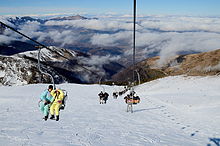|
Tourism in Kosovo
Tourism in Kosovo is characterized by archaeological heritage from Illyrian, Dardanian, Roman, Byzantine, Serbian and Ottoman times, traditional Albanian and Serbian cuisine, architecture, religious heritage, traditions, and natural landscapes. Kosovo is situated in south-eastern Europe. With its central position in the Balkans, it serves as a link in the connection between central and south Europe, the Adriatic Sea, and Black Sea. The New York Times included Kosovo on the list of 41 Places to go in 2011.[1][2] In the same year, Kosovo saw a jump of about 40 places on the Skyscanner flight search engine which rates global tourism growth.[3][4] Kosovo's monuments are classified as common property for which the society is responsible to maintain them in order to transmit their authenticity to future generations.[5][6] Kosovo has a variety of natural features. It is surrounded by mountains: the Sharr Mountains are located in the south and southeast, bordering North Macedonia, while the Kopaonik mountain range rise in the north. The southwest borders with Albania and Montenegro are also mountainous and home to the country's highest peak, Gjeravica, 2,656 m (8,714 ft) high. The bulk of international tourists going to Kosovo are from Albania, Germany, Italy, the United States, the United Kingdom, Croatia and Austria. Tourism is a growing sector with more tourists visiting every year. Natural attractionsNational parksKosovo has two declared national parks and those are the Bjeshkët e Nemuna National Park and Sharr Mountains National Park.  Bjeshkët e Nemuna National Park is located in the districts of Gjakova and Peja in the Accursed Mountains range in western Kosovo. Spanning over 63,028 hectares (155,750 acres) of rugged mountains, the area boasts a multitude of lakes, thick deciduous and coniferous forests, and alpine vistas. Its designation as a park stems from the need to safeguard the diverse ecosystems, biodiversity, and the rich tapestry of cultural and historical heritage it holds. Sharr Mountains National Park, situated in southwestern Kosovo, it unfolds its natural beauty. Encompassing 53,272 hectares (131,640 acres), the national park includes diverse landscapes, the park features glacial lakes, as well as alpine and periglacial terrains.[7] It was declared a national park in 1986, and re-established in 2012 by the new Kosovar Government. Other White Drin Waterfall and the Bukuroshja e Fjetur Cave, both located near each other in the Accursed Mountains in the north of Peja, are some of the most famous tourist destinations in Kosovo, drawing thousands of visitors from both local and international origins.[8]  Located on the slopes of Sharr Mountains in southern Kosovo, the Brezovica ski resort claims its status as the premier hub for winter tourism in Kosovo. During winter, mainly skiing and snowboarding take place. As the seasons transition to summer, the resort transforms into an eco-tourism haven, offering opportunities for hiking, mountain biking, golf and various outdoor activities.[9] Other natural attractions include Lake Batllava, Mirusha Waterfalls, Gjeravica, Marble Cave, Rugova Canyon. CitiesSome of the most visited cities include:

Architecture
StatisticsThe Statistical Agency of the Kosovo publishes hotel statistics on a quarterly basis since 2008. In 2023, the reported number of hotel nights spent by non-residents was 746,501 compared to 544,701 in the previous year. The number of foreign visitors also increased from 297,588 in 2022 to 357,717 in 2023.[16] The following table illustrates the number of non resident visitors according to country of origin recorded in 2023. The data was issued by the Statistical Office of the Republic of Kosovo.
Issues regarding entering KosovoSerbia considers Kosovo to be an integral part of its territory and thus does not consider the designated crossing with Kosovo to be an international border. Serbia does not apply entry or exit stamps to the passports of those using these crossings. Serbia also does not recognize the designated entry points between Kosovo (including Pristina airport) and third countries because they are not under the control of Serbian authorities. Foreign nationals have been denied entry to Serbia by Serbian border officials if they don't have a current Serbian entry stamp in their passport. If a visit to Serbia is planned after visiting Kosovo, entering Serbia via North Macedonia is recommended.[17][18][19] Citizens of Albania, Montenegro and Serbia may use a national ID card at border crossings with no stamping involved. Meanwhile, citizens of EU countries, North Macedonia, Monaco and San Marino may use a biometric national ID card (excluding e.g. Austrian, French and Greek citizens, but including e.g. Dutch, German and Swedish citizens) See also
Annotations and references
External linksWikivoyage has a travel guide for Kosovo. Wikimedia Commons has media related to Tourism in Kosovo.
Official sitesNews articles
Travel publications |

